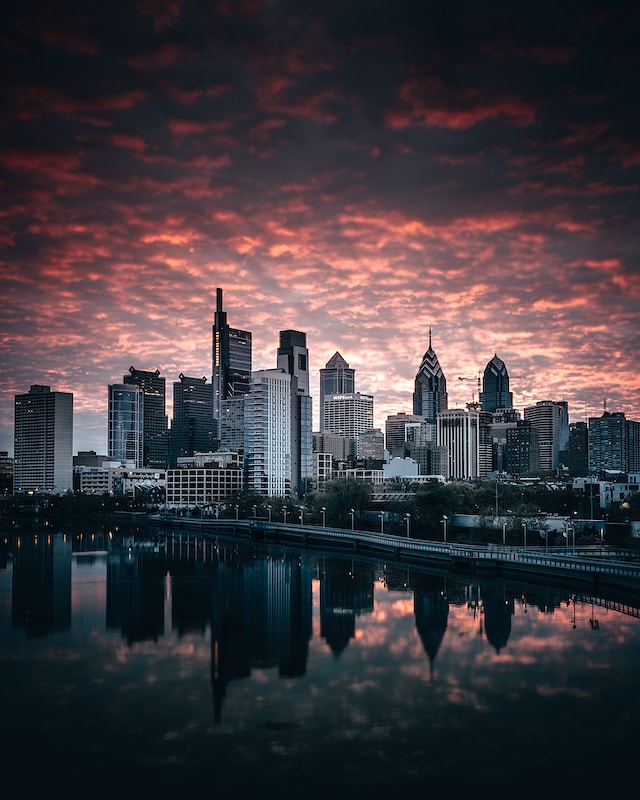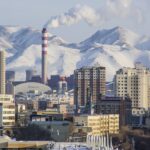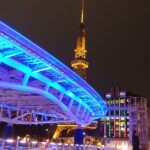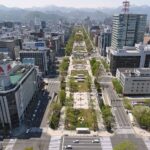The Southeastern Pennsylvania Transportation Authority offers public transit in Philadelphia (SEPTA). Throughout the entire city, SEPTA runs regional rail, trolleys, buses, and subways. The 30th Street Station, which connects to Amtrak, SEPTA, and PATCO services, is the city’s primary public transit hub. People may easily travel within the city as well as to and from the suburbs thanks to the availability of public transit.
Metro system in Philadelphia: basic information
The Philadelphia subway system, formally known as the Southeastern Pennsylvania Transportation Authority (SEPTA), is an integral part of the city’s public transportation network. With over 280 active stations and more than 450 miles of track, the SEPTA system offers a convenient and efficient way to navigate through the City of Brotherly Love. The subway system is composed of four primary lines:
The Broad Street Line – Orange
The Broad Street Line, also known as the Orange Line, is the oldest subway line in Philadelphia. It operates from Fern Rock Transportation Center in North Philadelphia to Pattison Avenue in South Philadelphia. The line, named after the street it travels underneath, runs exclusively north-south and is approximately 13.6 miles long. The Broad Street Line includes 22 stops and has a daily ridership of over 125,000 passengers.
The Market-Frankford Line – Blue
Locals call the Market-Frankford Line the “Blue Line.” It goes from the Frankford Transportation Center in Northeast Philadelphia to the 69th Street Transportation Center in Upper Darby, Pennsylvania. This line runs mostly from east to west and goes under Market Street in the middle of Philadelphia. It is about 13.6 miles long. It is the busiest line in the SEPTA system. It has 28 stops and serves more than 180,000 people every day.
the Norristown High-Speed Line
The Norristown High Speed Line is a 13.4-mile line that goes from the 69th Street Transportation Center in Upper Darby to the Norristown Transportation Center. Because the third rail and the overhead catenary are both used to power the trains on this line, it is special. It stops at 22 places and serves about 10,000 people every day.
PATCO Hi-Speedline
The PATCO Hi-Speedline is a rapid transit system that runs between Philadelphia, Pennsylvania, and Camden County, New Jersey. The line is 14.2 miles long and consists of 13 stations, four of which are located in Philadelphia, and the rest are scattered across New Jersey. The line operates 24 hours a day, serving approximately 38,000 passengers per day.
Each of these train lines gives you a different view of the city and carries a different kind of person. From the busy city hub of downtown Philadelphia to the quieter suburbs of Upper Darby and Norristown, the SEPTA system is an important way for people in the greater Philadelphia area to get around. The fact that Philadelphia has a train system shows how much the city cares about public transportation. Even though the system is old, it keeps changing and adapting to meet the needs of Philadelphia’s growing population. No matter if you live in Philadelphia or are just visiting, the SEPTA system is an easy, safe, and quick way to get around the city.
Map of Philadelphia Metro 2023 – Free Download in PDF

Click on the image and download the map of Philadelphia´s underground system for 2023
Free PDF downloads of The Map of Philadelphia Metro 2023 are available. It offers a thorough analysis of the city’s public transportation system. It offers thorough maps of every bus and subway route in addition to details on transfers, riding advice, and other topics. The neighborhoods, parks, and tourist attractions of the city are also depicted on the map. Travelers may simply plan their routes around the city using this map, ensuring that they reach their destinations swiftly and safely. Anyone who wants to learn more about the city and its public transit system should use this resource.
Public transport tickets in Philadelphia: the Best types for travelers & actual prices
There are numerous public transit alternatives in the thriving metropolis of Philadelphia for both tourists and residents. There are many tickets available to fit your needs, whether you’re a visitor looking to experience the city or a native needing to move around town. Here is a list of the various ticket categories and their associated costs.
A SEPTA Transit Pass, which entitles you to unlimited travel on buses, trolleys, and subways for one day or up to seven days, is the least expensive and most adaptable choice. A seven-day pass costs $27.50 while a one-day pass is $13. A one-day pass for SEPTA costs $9 if you intend to use it several times in a single day.
A SEPTA Key card, a reloadable fare card you can use on buses, trolleys, and subways, provides an additional choice. It can also be used to buy weekly or monthly passes or to save money. The card itself costs $4.95, and you can then add money to it. The cost of a monthly admission is $91, while a weekly pass is $25.50.
You can purchase individual tickets at the station if you’re just utilizing SEPTA to navigate the city. Tickets for a single ride cost $2.50 and can be purchased with cash or a credit/debit card.
The best choice for visitors to the city is a three-day pass, which costs $19. This allows you three days of unrestricted usage of SEPTA buses, trolleys, and subways, so you can travel around the city without worrying about how much each trip will cost.
Timetables & Schedules of the Philadelphia Metro System
Regular service for the Philadelphia Metro system runs from 5:00 AM through midnight, Monday through Saturday. The system is operational on Sundays from 8:00 AM until 11:00 PM. Moreover, the trains run every half-hour between the hours of 5:00 AM and 7:00 PM. The trains operate on a more condensed timetable of every hour late at night. Depending on the line, the last train usually leaves the final station at about 12:30 AM. Moreover, on Fridays and Saturdays, Philly Metro provides a late-night service that lasts until 2:00 AM.
What Are Other Options For Public Transportation In Philadelphia?
Outside its well-known metro system, Philadelphia is home to a variety of public transit choices. Both locals and visitors may easily find a method to travel to their destination without depending on their own car thanks to the city’s abundance of transportation choices.
The SEPTA bus system is one of the most well-liked forms of public transit in Philadelphia. SEPTA provides a variety of bus lines that connect the city’s many areas and make it simple to reach the city’s main attractions. The bus system also provides a variety of express routes that might enable people who are pressed for time to get where they need to go quickly.
The Philadelphia trolley system is a fantastic choice for people seeking a quicker means of transportation. The SEPTA bus and metro systems are connected to the trolleys, which provide an effective means to move about the city. The trolleys provide a fantastic view of the city as you travel around the city’s lines.
Commuter rail service in Philadelphia provides an additional means of getting around the city. For people who need to go larger distances, the commuter rail is an excellent option because it provides service to numerous city neighborhoods. The commuter rail is an excellent option for traveling to the suburbs and provides links to various areas of the Philadelphia metropolitan area.
How To Get From Philadelphia International Airport (phl) To The City Center With Public Transport?
Public transportation makes getting to the city center from Philadelphia International Airport (PHL) simple. Travelers can choose the best method of transportation from the airport to their destination by reviewing the options presented in this guide.
The SEPTA Airport Regional Rail Line is the most practical route from PHL to the city center. This line runs from the airport to the city’s central 30th Street Station. The trip costs $8.25 USD and lasts roughly 25 minutes. Trains depart every 30 minutes, seven days a week.
The 115 bus, which leaves from Terminal F and travels directly to the city center, is another alternative. The ticket is $2.50 USD and the trip lasts roughly 45 minutes. The 115 is operational every single day of the week.
The Subway-Surface Trolley Lines provide two lines that connect PHL to the city center for those who want a more direct approach. From Terminal A-East, the Subway-Surface Line 10 travels to the city’s 15th Street Station. The ride costs $2.50 USD and lasts roughly 30 minutes. From Terminal A-West, the Subway-Surface Line 13 travels to the city’s main station, 8th Street. The ride costs $2.50 USD and lasts roughly 25 minutes. Every 15 minutes, both lines depart. They are both open seven days a week.
What kind of sightseeing do you have to see if you visit Philadelphia for the first time?
The birthplace of the United States of America, Philadelphia, is a city rich in culture and history. There are a ton of attractions in the city, including the famous Liberty Bell and other museums. Below is a list of Philadelphia’s best tourist destinations.
- The Liberty Bell is one of the most recognizable emblems of the United States, according to the Liberty Bell Center. Learn about the significance and history of the bell at the Liberty Bell Center. The Declaration of Independence, which was drafted in Philadelphia in 1776, is also included in an exhibit at the center.
- One of the biggest and most well-known museums of art in the world is the Philadelphia Museum of Art. It includes a sizable collection of international artwork, such as pieces by Monet, van Gogh, and Rembrandt. Throughout the year, the museum also sponsors specialized exhibitions and activities.
- Independence Hall: In 1776 and 1787, respectively, the Declaration of Independence and the Constitution were signed in Independence Hall. As a National Historic Landmark, the hall is accessible by guided tours.
- More than 1,000 species from all over the world call the Philadelphia Zoo, one of the country’s oldest zoos, home. Many animal displays, educational programs, and special events are available at the zoo.
- Reading Terminal Market: Reading Terminal Market is a terrific place to grab a bite to eat and is the oldest continuously running public market in the United States. There are numerous merchants at the market selling fresh produce, cooked dishes, and trinkets.
- Please Touch Museum: For kids, the Please Touch Museum is a fun and engaging attraction. Children of all ages will enjoy the interactive exhibits, educational events, and hands-on activities at the museum.
- Franklin Institute: The Franklin Institute is a science museum with a range of engaging displays, educational activities, and in-person demonstrations. It is a fantastic site to learn about science and history and is devoted to the life and work of Benjamin Franklin.
These are just a few of Philadelphia’s best tourist destinations. This wonderful city has something for everyone, whether you’re interested in discovering the arts, learning about history, or simply having fun with the family.
What other metro systems are nearby to Philadelphia
Philadelphia is conveniently located near several other metro systems. To the north, the New York City Metro system, one of the largest and busiest in the world, is about 90 miles away. To the south, the Washington D.C. Metro system is approximately 130 miles away, providing access to the nation’s capital and its surrounding areas. Closer to Philadelphia, the South Jersey/Philadelphia metro area is served by the PATCO Speedline, while the city’s western suburbs are connected by the SEPTA regional rail system. Hence, Philadelphia is well-connected with several significant metropolitan regions.
CHECK OUT THIS AWESOME VIDEO TOUR GUIDE ABOUT PUBLIC TRANSPORTATION IN philadelphia
Summary of our tour guide for Philadelphia
As a resident of Philadelphia for over a decade, I have frequently relied on the city’s public transportation system. The Southeastern Pennsylvania Transportation Authority, or SEPTA, has been an integral part of my daily commute. From the subway lines to the bus routes, I’ve found it to be a generally reliable and convenient option for getting around the city. While there have been days where delays and crowded conditions tested my patience, the affordability, and accessibility have made it a realistic choice for me. Plus, using public transportation has given me the opportunity to interact with a diverse cross-section of Philadelphians, fostering a sense of community and connectedness that I might not have experienced otherwise.
Top 5 FAQs and answers about Philadelphia public transport?
What kinds of public transportation does Philadelphia offer?
- The public transportation network in Philadelphia offers both bus and rail services. More than 600 bus lines, as well as the Market-Frankford Line (the “El”), the Broad Street Line, and the Norristown High-Speed Line are run by the Southeastern Pennsylvania Transportation Authority (SEPTA). The city and its suburbs are also served by a variety of privately owned bus companies.
What are the ticket costs?
- The cost of the fare varies according to the service type and distance traveled. The cost of a ride on a SEPTA bus is $2.50, and the cost of a ride on an El, Broad Street Line, or Norristown High-Speed Line is $2.50, regardless of how long the trip is. The prices for privately run bus companies range from $1 to $3.
Do you offer any special deals?
- Yes. Seniors, students, and those with disabilities who use SEPTA can receive discounted rates. Moreover, SEPTA provides weekly and monthly transit passes for a set rate that permits unrestricted use of all SEPTA routes.
I need to know how to pay for public transit.
- Cash, tokens, and passes are accepted forms of payment for public transit. The most well-liked and practical method of paying for SEPTA services is via SEPTA Key Cards, which can be acquired online or at specific locations.
Where can I find out more about Philadelphia’s public transportation?
- The SEPTA website has further details regarding public transportation in Philadelphia. The Philadelphia Transportation Authority and the Philadelphia Visitors Bureau also offer comprehensive information about the city’s public transit system.
Useful links







